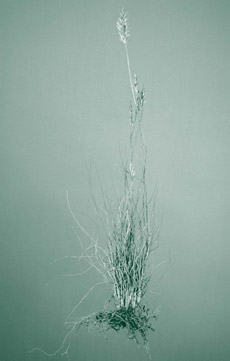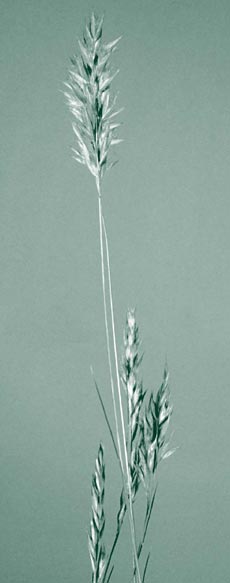
Austrodanthonia bipartita (Wallaby grass)
Description

Austrodanthonia bipartita is regarded as a valuable native grass in the pastoral areas of Australia. A. bipartita is a year-long green plant that produces palatable high quality fodder during the cooler months. Seed heads appear white and fluffy. Austrodanthonia spp. have a reputation for prolific seedling recruitment and respond well to moderate grazing.
Morphology
A. bipartita is a tufted perennial 0.3–0.75m tall with a densely tufted base. Characteristically, A. bipartita have leaves that are long and slender and usually smooth and hairless. The seed heads are oblong in outline and spikelets (Spikelet - consists of one or more florets and is the basic unit of the inflorescence in grasses) are loosely clustered. A. bipartita lemmas (Lemma - the outer bracts at the base of a grass spikelet; usually two glumes are present) are hairy all over the back.
Distribution
A. bipartita is distributed throughout the temperate higher rainfall areas of Australia. This species is mainly found on heavy soils, particularly those of basalt origin.
Harvesting
Time
Harvesting time can differ depending on the location of the species. Around Deniliquin, (NSW), the growing season is mainly after autumn rains and peak production is often reached in spring. Further south seed can be harvested later, e.g. Tasmanian populations can be harvested in mid summer. In cool moist environments with a reliable winter dominant rainfall pattern, such as in Tasmania and Victoria, seed is produced in response to day length. Conversely in hot semi-arid environments of central western New South Wales, control of reproduction appears to be more opportunistic and growth followed by flowering can occur whenever adequate rains fall. Harvesting in the northern more arid regions of New South Wales should therefore follow specific rainfall events rather than season.

Methods
To-date hand, vacuum and brush harvesting have proved to be successful for harvesting seed of this species. Some processing may be required as seed is extremely hairy. Hand separation and the clipper have proved to be useful techniques for processing seed. Conical threshers followed by aspiration to remove trash can be used to process the seed to give naked caryopses (Caryopsis - the indehiscent fruit of most grasses with a single seed, the testa (seed coat) of which is fused with the pericarp (outer wall)).
Seed storage
Seed should be stored for more than 6 months to avoid any problems with the primary dormancy period and lemmas and paleas should be left intact. Seeds should be stored at ambient temperatures and protected from sunlight and vermin.
Sowing
Ideal conditions
Optimum germination percentages are achieved at soil temperatures above 20°C for seed that is greater than 6 months old. The ideal sowing time is autumn (April and May), however early spring sowing can be undertaken if establishment occurs before the onset of hot, dry conditions of summer. The likelihood of rainfall may be more important than temperature when determining sowing date. Although the seeds are small, sowing depth should be restricted to just below the surface (2 mm). Broadcasting seed has also been successful however, moisture conditions become critical with this procedure. When sowing in a dryland situation fluffy seed should be used but under irrigation, good germination rates can be achieved using naked caryopses.
Methods
Broadcasting seeds on disturbed surfaces has resulted in good establishment rates. Seeds can also be sown at a shallow depth using tynes. Conventional seed boxes have proved unsuccessful as the fluffy nature of the seed causes major problems with bridging and clinging. However, if naked caryopses are used, then conventional small boxes are satisfactory. A light harrow following broadcasting will assist in providing good soil/seed contact. Seed has also been successfully sown using band seeders or the crocodile seeder in lower rainfall areas.
Weed control
Producing a weed-free seedbed is essential prior to sowing, as this species has shown little tolerance to herbicides at the seedling stage.
Management
A. bipartita has the ability to readily colonise areas following cultivation. This species can also handle grazing well and probably requires some grazing to flourish. An absence of grazing for extended periods results in a decline in plant numbers and longevity.
Other species
- Astrebla lappacea (Curly Mitchell grass)
- Astrebla pectinata (Barley Mitchell grass)
- Austrodanthonia caespitosa (White top)
- Austrodanthonia richardsonii (Wallaby grass)
- Bothriochloa macra (Red grass)
- Chloris truncata (Windmill grass)
- Dichanthium sericeum (Queensland bluegrass)
- Elymus scaber (Common wheat grass)
- Heteropogon contortus (Black speargrass)
- Microlaena stipoides (Microlaena or Weeping grass)
- Paspalidium constrictum (Box grass)
- Paspalidium jubiflorum (Warrego summer grass)
- Themeda triandra (Kangaroo grass)

